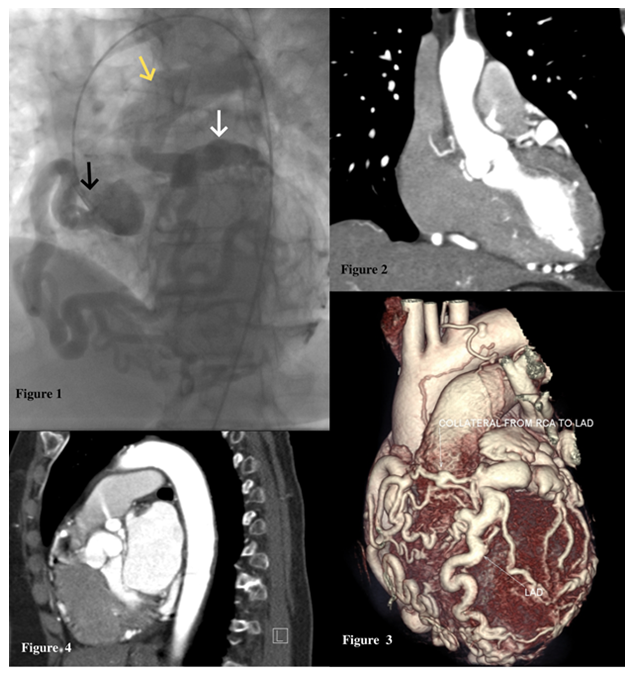Asymptomatic Anomalous Left Coronary Artery from the Pulmonary Artery (ALCAPA) in an Adult
Demetrio Sharp Dimitri1*, Patrick Albertus1, Muhammad Khan1, Andrew Panakos2, Carlos E Alfonso2, Vicente Orozco-Sevilla1
1Department of Internal Medicine, University of Cincinnati Medical Center, Cincinnati, USA
2Department of Cardiovascular Disease, University of Miami Health, Miami, USA
*Corresponding Author: Demetrio Sharp Dimitri, Department of Internal Medicine, University of Cincinnati Medical Center, Cincinnati, USA
Received: 16 February 2023; Accepted: 12 May 2023; Published: 23 May 2023
Article Information
Citation: Demetrio Sharp Dimitri, Patrick Albertus, Muhammad Khan, Andrew Panakos, Carlos E Alfonso, Vicente Orozco-Sevilla. Asymptomatic Anomalous Left Coronary Artery from the Pulmonary Artery (ALCAPA) in an Adult. Journal of Surgery and Research. 6 (2023): 215-216.
View / Download Pdf Share at FacebookAbstract
Anomalous origin of the left coronary artery from the pulmonary artery (ALCAPA) is considered a rare and very fatal congenital coronary artery anomaly. It is estimated that this congenital abnormality affects 1 of every 300,000 live births and accounts for 0.25% of all congenital heart defects worldwide. ALCAPA manifests itself most commonly in infant population and it has a 1-year mortality rate of approximately 90%, therefore it is not often considered a diagnosis in the adult population [1,2]. When it presents in adult it is considered an important cause of sudden cardiac death [3,4]. We describe a patient in whom this anomaly was diagnosed during cardiac catheterization for evaluation of progressive shortness of breath and mild to moderate mitral regurgitation founded on a transthoracic echocardiogram [5].
Keywords
ALCAPA, Mitral valve regurgitation, Congenital cardiac defect, Coronary anomaly
ALCAPA articles; Mitral valve regurgitation articles; Congenital cardiac defect articles; Coronary anomaly articles
ALCAPA articles ALCAPA Research articles ALCAPA review articles ALCAPA PubMed articles ALCAPA PubMed Central articles ALCAPA 2023 articles ALCAPA 2024 articles ALCAPA Scopus articles ALCAPA impact factor journals ALCAPA Scopus journals ALCAPA PubMed journals ALCAPA medical journals ALCAPA free journals ALCAPA best journals ALCAPA top journals ALCAPA free medical journals ALCAPA famous journals ALCAPA Google Scholar indexed journals Mitral valve regurgitation articles Mitral valve regurgitation Research articles Mitral valve regurgitation review articles Mitral valve regurgitation PubMed articles Mitral valve regurgitation PubMed Central articles Mitral valve regurgitation 2023 articles Mitral valve regurgitation 2024 articles Mitral valve regurgitation Scopus articles Mitral valve regurgitation impact factor journals Mitral valve regurgitation Scopus journals Mitral valve regurgitation PubMed journals Mitral valve regurgitation medical journals Mitral valve regurgitation free journals Mitral valve regurgitation best journals Mitral valve regurgitation top journals Mitral valve regurgitation free medical journals Mitral valve regurgitation famous journals Mitral valve regurgitation Google Scholar indexed journals Congenital cardiac defect articles Congenital cardiac defect Research articles Congenital cardiac defect review articles Congenital cardiac defect PubMed articles Congenital cardiac defect PubMed Central articles Congenital cardiac defect 2023 articles Congenital cardiac defect 2024 articles Congenital cardiac defect Scopus articles Congenital cardiac defect impact factor journals Congenital cardiac defect Scopus journals Congenital cardiac defect PubMed journals Congenital cardiac defect medical journals Congenital cardiac defect free journals Congenital cardiac defect best journals Congenital cardiac defect top journals Congenital cardiac defect free medical journals Congenital cardiac defect famous journals Congenital cardiac defect Google Scholar indexed journals Coronary anomaly articles Coronary anomaly Research articles Coronary anomaly review articles Coronary anomaly PubMed articles Coronary anomaly PubMed Central articles Coronary anomaly 2023 articles Coronary anomaly 2024 articles Coronary anomaly Scopus articles Coronary anomaly impact factor journals Coronary anomaly Scopus journals Coronary anomaly PubMed journals Coronary anomaly medical journals Coronary anomaly free journals Coronary anomaly best journals Coronary anomaly top journals Coronary anomaly free medical journals Coronary anomaly famous journals Coronary anomaly Google Scholar indexed journals Cardio Thoracic surgery articles Cardio Thoracic surgery Research articles Cardio Thoracic surgery review articles Cardio Thoracic surgery PubMed articles Cardio Thoracic surgery PubMed Central articles Cardio Thoracic surgery 2023 articles Cardio Thoracic surgery 2024 articles Cardio Thoracic surgery Scopus articles Cardio Thoracic surgery impact factor journals Cardio Thoracic surgery Scopus journals Cardio Thoracic surgery PubMed journals Cardio Thoracic surgery medical journals Cardio Thoracic surgery free journals Cardio Thoracic surgery best journals Cardio Thoracic surgery top journals Cardio Thoracic surgery free medical journals Cardio Thoracic surgery famous journals Cardio Thoracic surgery Google Scholar indexed journals myocardial ischemia articles myocardial ischemia Research articles myocardial ischemia review articles myocardial ischemia PubMed articles myocardial ischemia PubMed Central articles myocardial ischemia 2023 articles myocardial ischemia 2024 articles myocardial ischemia Scopus articles myocardial ischemia impact factor journals myocardial ischemia Scopus journals myocardial ischemia PubMed journals myocardial ischemia medical journals myocardial ischemia free journals myocardial ischemia best journals myocardial ischemia top journals myocardial ischemia free medical journals myocardial ischemia famous journals myocardial ischemia Google Scholar indexed journals valvular disease articles valvular disease Research articles valvular disease review articles valvular disease PubMed articles valvular disease PubMed Central articles valvular disease 2023 articles valvular disease 2024 articles valvular disease Scopus articles valvular disease impact factor journals valvular disease Scopus journals valvular disease PubMed journals valvular disease medical journals valvular disease free journals valvular disease best journals valvular disease top journals valvular disease free medical journals valvular disease famous journals valvular disease Google Scholar indexed journals Angiography articles Angiography Research articles Angiography review articles Angiography PubMed articles Angiography PubMed Central articles Angiography 2023 articles Angiography 2024 articles Angiography Scopus articles Angiography impact factor journals Angiography Scopus journals Angiography PubMed journals Angiography medical journals Angiography free journals Angiography best journals Angiography top journals Angiography free medical journals Angiography famous journals Angiography Google Scholar indexed journals right coronary artery articles right coronary artery Research articles right coronary artery review articles right coronary artery PubMed articles right coronary artery PubMed Central articles right coronary artery 2023 articles right coronary artery 2024 articles right coronary artery Scopus articles right coronary artery impact factor journals right coronary artery Scopus journals right coronary artery PubMed journals right coronary artery medical journals right coronary artery free journals right coronary artery best journals right coronary artery top journals right coronary artery free medical journals right coronary artery famous journals right coronary artery Google Scholar indexed journals
Article Details
Case
A 58-year-old otherwise hypertensive female that was evaluated because of her progressive shortness of breath and mild to moderate mitral regurgitation founded on a transthoracic echocardiogram. Her physical examination showed a regular heart rate and rhythm, with normal heart sounds with an II/III holosystolic systolic murmur on the 4th intercostal midclavicular line, no rubs or gallops were present on auscultation. No lower extremity pitting edema was noticed. Electrocardiography showed normal sinus rhythm and criteria and possible left ventricular hypertrophy. Stress Echocardiogram with no evidence of ischemia and preserved left ventricular function with an ejection fraction of 55-60%, left atrium dilated with mild to moderate mitral regurgitation. Patient underwent a coronary catheterization which indicated no evidence of obstructive coronary disease, normal left ventricular function with mild to moderate mitral insufficiency. Angiography of the right coronary artery showed a very large and tortuous artery that collateralizes into the left main system and supplies the entire left coronary artery system. The left main coronary origin was from the pulmonary artery. CTA confirmed the same findings. The recommendations between cardiology and Cardio Thoracic surgery were to maximize medical therapy including beta blockers and diuresis and close follow up due to the lack of myocardial ischemia, severe valvular disease or heart failure.
Discussion
ALCAPA is a very rare condition in which the left main coronary artery originates on the pulmonary artery. The decreased flow into the left coronary arteries due to coronary artery steal from the low pulmonary artery resistance leads to ischemia and infarction of the myocardial tissue an usually is lethal if is not corrected as an infant [5]. The infant type of ALCAPA is considered to be very fatal if untreated with a 1-year mortality of approximately 90% [3]. Infants commonly present with failure to thrive, breathing difficulties, irritability, and distress while crying or eating. The adult type of ALCAPA is related to sudden cardiac death and symptoms of ischemia, mitral valve regurgitation, and left ventricular dysfunction [1,2]. The treatment of the ALCAPA infant type is absolutely surgically with either two-coronary system coronary button transfer, Takeuchi procedure (trans- pulmonary baffling), coronary artery bypass grafting (CABG) combined with ligation of the anomalous left coronary artery [1,2]. ALCAPA Adult type treatment is sometimes controversial, although the preferred approach is surgical including CABG combined with anomalous left coronary artery ligation and patch of the pulmonary artery [1,2]. This approach should only be considered if the patient adult has or develops evidence of ischemia, severe mitral regurgitation or heart failure secondary to a significant shunt and volume overload [1]. Currently there are no guidelines or gold standard management for patients with adult form of ALCAPA that present with minimal to non-disease of the myocardium? How can we monitor the disease course and possibly risk stratify patients for possible complications? Is there a screening benefit for patients with high probability of ALCAPA? How much real benefit does the surgical intervention really offers to this patient’s population group? What type of conduit is appropriate if CABG planned vein or double mammary. This case raises questions regarding the management of this rare congenital coronary anomaly.

Figure 1: Coronary obtained with a single RCA injection showing a tortuous and dilated RCA (Black Arrow) as well as an equally tortuous and dilated left coronary system (White Arrow). Contrast reaches the main pulmonary artery because of the pathologic steal phenomenon (Yellow Arrow). Figure 2: Chest CT. Evidencing opcification within the left coronary artery. Retrograde filling of left coronary artery circulation. Figure 3: 3-D CT Angiogram. RCA with a large number of collaterals feedinf the left coronary. Left coronary artery emerges from pulmonary artery trunk. Figure 4: Coronary CT. Anomalous left coronary artery originating from the pulomoary artery.
References
- Wesselhoeft H, Fawcett JS, Johnson AL. Anomalous origin of the left coronary artery from the pulmonary trunk: Its clinical spectrum, pathology, and pathophysiology, based on a review of 140 cases with seven further cases. Circulation 38 (1968): 403-425.
- Ishihata T, Takeda H, Katohno E, et al. An adult case of Bland-White-Garland syndrome with col- laterals from the bronchial artery. Heart Vessels 9 (1994): 218-222.
- Arciniegas E, Farooki ZQ, Hakimi M, et al. Management of anomalous left coronary artery from the pulmonary artery. Circulation 62 (1980): I180-I189.
- Fernandes ED, Kadivar H, Hallman GL, et al. Congenital malformations of the coronary arteries: the Texas Heart Institute ex- perience. Ann Thorac Surg 54 (1992): 732-740.
- Alexi-Meskishvili V, Berger F, Weng Y, et al. anomalous origin of the left coronary artery from the pulmonary artery in adults. J Card surg 10 (1995): 309-315.


 Impact Factor: * 4.2
Impact Factor: * 4.2 Acceptance Rate: 72.62%
Acceptance Rate: 72.62%  Time to first decision: 10.4 days
Time to first decision: 10.4 days  Time from article received to acceptance: 2-3 weeks
Time from article received to acceptance: 2-3 weeks 